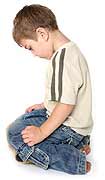
MONDAY, May 2 (HealthDay News) — The brains of 4- and 5-year-old children with autism are larger than the brains of normally developing children, and the difference probably occurs several years earlier, a new study suggests.
The finding is a follow-up to earlier research that found the brains of 2-year-olds with autism are larger than those of similarly aged normally developing kids, researchers said.
“Our prior paper found that at age 2, children with autism had brain overgrowth, meaning their brains were larger than the comparison children,” said study author Heather Cody Hazlett, an assistant professor in the department of psychiatry at University of North Carolina, Chapel Hill School of Medicine.
“We now know this overgrowth was maintained,” Hazlett added. “The children with autism kept having significantly enlarged brains at 4 and 5 years old.”
On average, autistic children’s brains were 9 percent larger than those of other kids.
In the United States, about 1 in every 110 children has autism, a neurodevelopmental disorder marked by social and communication impairment, according to the U.S. Centers for Disease Control and Prevention. The study is published in the May issue of the Archives of General Psychiatry.
Hazlett and her colleagues did MRIs on 59 children aged 18 to 35 months with an autism spectrum disorder and 38 children who did not have autism. Two years later, about 38 children with an autism spectrum disorder and 21 typically developing kids returned for a follow-up MRI.
Researchers were interested in volume of white matter (the connective tissue of the brain), gray matter (made up of neurons), cortical thickness and brain surface area.
At age 2, autistic kids had a larger total brain volume than non-autistic kids.
Two years later, researchers were able to measure cortical thickness and brain surface area, in addition to volume.
They found autistic kids had larger brain volume and greater brain surface area, though they did not show a difference in cortical thickness. The rate of brain growth was about the same in children with and without autism.
The findings suggest that the brain overgrowth is occurring prior to age 2, and perhaps prior to age 1, she said.
Data on head circumference of children with ASD compared with control children suggests that increased head size in autism starts at around age 1, according to background information in the article. Behavioral changes of children who were developing normally at 6 months are often noticed by 12 months in kids later diagnosed with autism.
Prior research has linked greater brain surface area to genes that promote the proliferation of neurons.
“What we know is that the mechanism for the folding of the brain is genetic in origin, resulting from an increase in the proliferation of neurons,” she said.
Dr. Andrew Adesman, chief of developmental and behavioral pediatrics at Steven and Alexandra Cohen Children’s Medical Center of New York, said the findings are interesting, although they don’t have immediate clinical applications.
However, understanding that the “brain overgrowth” at age 2 remains stable through age 4 — meaning that it doesn’t become more pronounced, nor does other kids’ brain size catch up — does suggest that researchers should start looking even earlier in life to see when the brain overgrowth begins.
“It does encourage researchers to more closely evaluate brain development in the months just before and after a child’s first birthday, since this is when early signs of autism often manifest initially and when changes in head size also become evident,” Adesman said.
What’s also unknown is whether the brain overgrowth seen in young children with autism coincides with or precedes the onset of symptoms, he added.
More information
The U.S. National Institute of Mental Health has more on autism.

